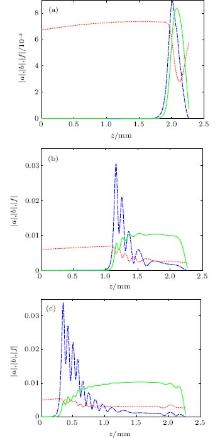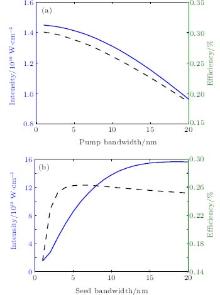Corresponding author. E-mail: sujingqin@hotmail.com
Project supported by the National Natural Science Foundation of China (Grant No. 11305157) and the Development Foundation of China Academy of Engineering Physics Laboratory (CAEPL) (Grant No. 2013A0401019).
Chirped wideband pump and seed pulses are usually considered for backward Raman amplification (BRA) in plasmas to achieve an extremely high-power laser pulse. However, current theoretical models only contain either a chirped pump or a chirped seed. In this paper, modified three-wave coupling equations are proposed for the BRA in the plasmas with both chirped wideband pump and seed. The simulation results can more precisely describe the experiments, such as the Princeton University experiment. The optimized chirp and bandwidth are determined based on the simulation to enhance the output intensity and efficiency.
Hundreds of petawatt or even exawatt pulse power can be achieved by backward Raman amplification (BRA) in plasmas.[1– 4] The BRA is an effective way for fast compression.[5– 12] However, the total efficiency is only 6.5%, [9] far less than the theoretical predictions of 80%, [1] 65%, [13] and 35%.[2] A significant cause of this problem is the frequency detuning caused by the pump and seed chirp or the density gradient of the plasmas. Although a well-designed frequency detuning can help the amplification to achieve the non-linear regime by the filtering effect, [14] the efficiency usually decreases by weakening the exact resonance of the BRA in the plasmas.
Theories of the chirped pump or seed for the BRA in plasmas have been reported in several references. On one hand, super-radiant linear Raman amplification (SLRA) in plasmas was proposed in Ref. [15] with a chirped pump. On the other hand, the pump chirp is called a negative element for the scheme because it drives the interaction away from the exact resonance.[16] Furthermore, the seed chirp enhances the efficiency through the effect of group velocity dispersion in high-density plasmas (ne ≈ 1021 cm– 3).[17] Nevertheless, those reports have not combined the effects of the pump chirp and the seed chirp. In addition, the seed chirp in experiments (usually much smaller than the pump chirp) can lead to an extremely fast oscillating phase, requiring the modification of the coupling equations. Meanwhile, the pump and the seed bandwidths should be considered in the theoretical model because they can also result in frequency detuning. In this paper, modified three-wave coupling equations are proposed by introducing these effects.
Two methods are usually used to obtain the expected pump or seed intensity. In one method, the pulse is stretched or compressed by different gratings without changing the bandwidth. In this way, only the pulse chirp is changed. In the other method, the pulses with different bandwidths are chosen but compressed by the same gratings, so the pulse chirp is stable but the bandwidth is changed. These two methods correspond to independent variations of the chirp and the bandwidth. In our simulation, the influences of the chirp and the bandwidth on the scheme are discussed according to these two methods. Finally, their optimized values are determined to enhance the intensity and efficiency of the BRA in plasmas.
Assume that the modulated pump and seed respectively propagate along the positive and the negative z axis through a plasma channel, then their united vector potential can be written as
 |
where a and b are the normalized amplitudes of the pump and the seed, respectively, with corresponding modulation coefficients α and β and frequencies ω a and ω b.[15] The modulation coefficients can be presented as 
 |
where ω p is the frequency of the Langmuir wave, and n/n0 is the electron density perturbation in the plasmas. By using

and disregarding non-resonant and high-order terms, equation (2) reduces to
 |
where f is the envelope of the Langmuir wave, 

In the simulation, all parameters are adopted from the Princeton experiment.[9] Let the pump/seed wavelengths be λ a/b = 0.803/0.878 μ m. The ratio of the pump frequency to that of the Langmuir wave is ω a/ω p = 10. The pump (seed) is considered Gaussian with the maximum intensity of Ia = 2.3× 1014 W/cm2 (Ib = 1.3× 1012 W/cm2), FWHM duration of 20 ps (500 fs), and bandwidth of 10 nm (9 nm), corresponding to the transform-limited FWHM duration of 95 fs (126 fs) and chirp of ν a = 210.9 (ν b = 3.8). Thus, the modulation coefficients are α ≈ 1.46× 1024 s– 2 and β ≈ 4.26× 1025 s– 2. The normalized amplitudes a and b can be written as 
 |
where z = z0 is the position of the initial pump peak, and 

Figure 1 shows the profiles of the output pulses after the seed pulse prorates the 2-mm plasma channel. The integrated seed amplitude |b| is amplified 56.2 times from 
To verify the modified fluid model, a similar simulation is performed using a one-dimensional (1D) particle-in-cell (PIC) code employing the same parameters obtained from the Princeton experiment. Figure 2 illustrates the simulation results of the output intensity and spectrum. Most of the secondary spikes are suppressed because of the plasma wave breaking, thereby achieving a relatively higher maximum intensity (5.0 × 1015 W/cm2) and a smaller FWHM (119 fs) than those in the fluid model, as shown in Fig. 2(a). However, the output seed intensity still matches well with the results of the fluid model (Fig. 2(a)). The spectrum of the seed pulse (Fig. 2(b)) indicates that the pulse has a large amplification from 840 nm to 880 nm. However, the central wavelength changes to approximately 870 nm because of the frequency transfer in the interaction caused by the seed chirp.
The BRA efficiency can be written as
 |
where tf is the time that the seed pulse reaches the end of the 2-mm plasma channel. An efficiency of 23.4% is obtained from the simulation. The efficiency strongly depends on the pump intensity, as shown in Fig. 3(a). The efficiency is reduced to 0.5% when the intensity decreases to 1/e of the maximum value. The total efficiency with the parameters of the Princeton experiment [9] is then estimated to be approximately 12%, assuming the pump beam with a Gaussian transverse. Although this value is three times the experimental result (4%), it is closer to the experimental result than other theoretical predictions in the literature.[1, 2, 13, 18]
A high pump intensity is expected to enhance the output efficiency and intensity (Fig. 3(a)). However, the plasma wave breaking can be caused by a critical high-intensity pump, which requires the maximum input pump amplitude to be ≤ (ω p/ω )3/2/4.[1] Therefore, a pump intensity window is pointed out in several references.[2, 16] To broaden this window, high density plasmas and short wavelength pumps are needed.
The modulation of the pump and the seed can lead to the frequency detuning, as shown in Eq. (3), thus, the suitable bandwidth and chirp of the pump and the seed are essential to minimize the frequency detuning. The features of the BRA in plasmas brought by the chirp and the bandwidth of the pulses (both pump and seed) are discussed as follows.
Figure 3(b) shows the correlations of the pump chirp with the output intensity and efficiency. In this study, a stable pump amplitude is employed to maintain an excellent pump. Although the pump amplitude decreases following the chirp, it can also be maintained around a certain value by amplification or filtering. The pump chirp can seriously reduce the efficiency by aggravating the frequency detuning, as indicated in Fig. 3(b). On the contrary, the output intensity is enhanced by the pump chirp because a relatively long pumping length is obtained as the pump pulse is stretched by the chirp. In addition, the pump chirp is usually retained in experiments, thus the frequency detuning caused by the pump chirp is an essential negative factor for the output efficiency. To minimize the frequency detuning, plasmas with a certain gradient were proposed in Refs. [13] and [14]. However, the production of such a plasma channel remains extremely difficult.
The influence of the seed chirp on the output is presented in Fig. 3(c). The efficiency is also strongly associated with the frequency detuning δ ω , which is mainly determined by the modulation coefficient 
Figure 5 shows the influence of the bandwidth on the result. Similar to the pump chirp, a wider pump bandwidth reduces the efficiency because of the frequency detuning (Fig. 5(a)). On the contrary, a wider seed bandwidth enhances the efficiency because it can tolerate a larger frequency detuning (Fig. 5(b)). However, both the efficiency and the intensity decline slowly when the bandwidth is over a certain value because only part of the spectrum is effective. According to the simulation, good results are achieved when the seed bandwidth is about 1– 2 times that of the pump bandwidth. This result agrees with the experiment one in Ref. [7], in which only 10% of the input seed spectrum (840– 940 nm (FWHM)) was amplified.
A modified theoretical model was proposed in this study for the BRA with chirped wideband pump and seed pulses. The simulation results can describe experiments (e.g., Princeton University experiment) more precisely. Several conclusions were obtained for the chirp and the bandwidth of the pump and the seed. First, a large pump chirp with an appropriate intensity can enhance the output intensity, while it also results in a decreased efficiency. Second, the optimal result for the seed is achieved by the transform-limited seed (i.e., fully removed seed chirp). The lowest efficiency is obtained when the seed chirp is close to 1. Third, the pump chirp mainly influences the efficiency, whereas the seed chirp strongly affects the intensity amplification. Finally, a narrow bandwidth pump can achieve the optimal result at an appropriate intensity. The optimized bandwidth of the seed ranges is 1– 2 times that of the pump bandwidth.
| 1 |
|
| 2 |
|
| 3 |
|
| 4 |
|
| 5 |
|
| 6 |
|
| 7 |
|
| 8 |
|
| 9 |
|
| 10 |
|
| 11 |
|
| 12 |
|
| 13 |
|
| 14 |
|
| 15 |
|
| 16 |
|
| 17 |
|
| 18 |
|
| 19 |
|






